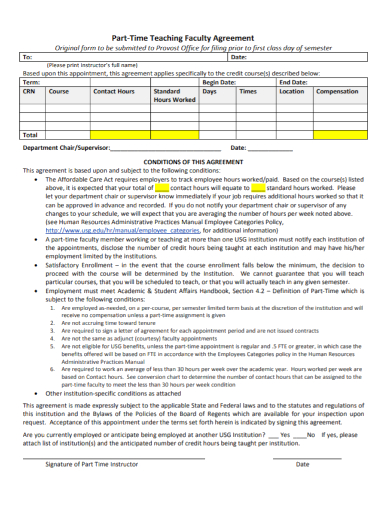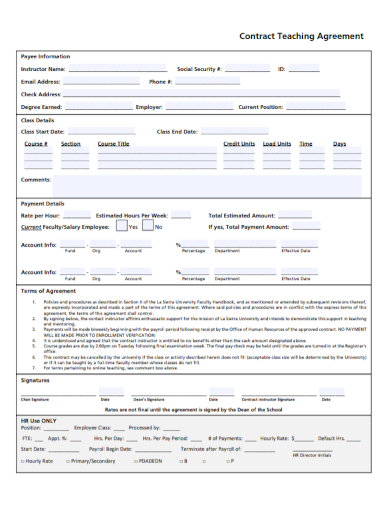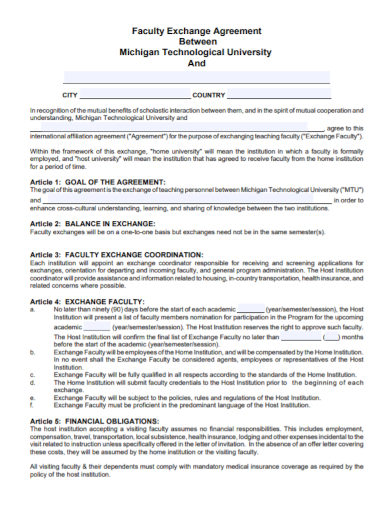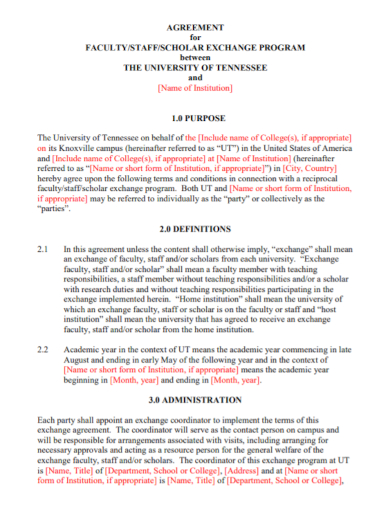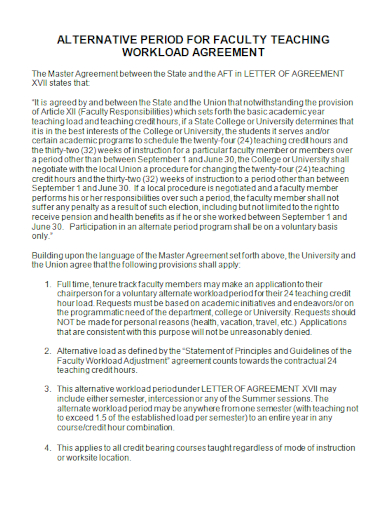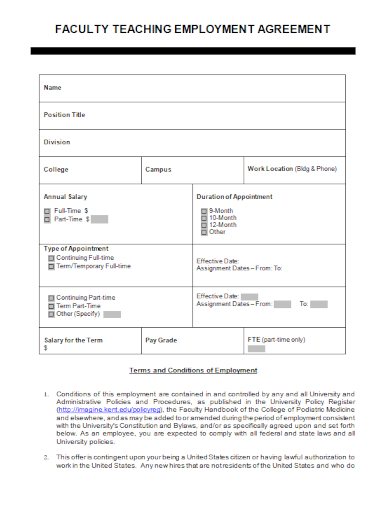5+ Teaching Faculty Agreement Samples
Teachers have a lot of duties at hand that sometimes you may look at it as something unmanageable, but by the power vested upon these professionals, teachers seem to have it all in terms of task management and schedule flexibility. But even if teachers are already functional enough individually, they still need to function as a team called “faculty”. Faculty members are expected to make decisions and discuss matters that would be of benefit for the students. In making this formalized and well-documented, there is a need to secure a Teaching Faculty Agreement. To avoid doing this from the very scratch, our site offers you a lot of templates that you can choose from. Just browse among these templates and choose the one that satisfies your needs the most.
For other agreement templates, our site is offering you these agreement templates that you can utilize when needed: Employee Equipment Agreement, Vendor Purchase Agreement, Vendor Merchandise Agreement, Vendor Service Agreement, Training Services Agreement, Teacher Agreement, Workshop Service Agreement, Student Teaching Agreement, Product Sales Agreement, Farm Land Lease Agreement, etc. This article will not only give you templates but also necessary information that you need to know for your teacher employment agreement/ contract. So come on, explore this article with me!
1. Part-Time Teaching Faculty Agreement
2. Faculty Contract Teaching Agreement
3. Faculty Teaching Exchange Agreement
4. Faculty Scholar Teaching Program Agreement
5. Faculty Teaching Workload Agreement
6. Faculty Teaching Employment Agreement
How To Make The Best Team Agreements?
- Have you ever felt that some decisions never seem to be made in your team?
- Have you ever felt that you keep having the same conversation over and over again?
- Are you tired of needing to explain the rules to your team members repeatedly?
If you have worked in a team, chances are you have experienced some of the above situations. You might even have found a few articles on how to resolve these challenges. Creating a team agreement is a great first step towards addressing these challenges.
Team agreements are sometimes referred to as social contracts. Research indicates that social contracts, if implemented correctly, have many positive benefits, such as giving employees a feeling of control and security in their relationships with their leader and teammates. These contracts also instill a sense of responsibility, accountability, and trust among team members. For the leader, these contracts help motivate desirable workplace behaviors and can discourage dysfunctional behaviors without heavy-handed surveillance. Using the Tuckman’s team development model, team agreements can help teams peacefully and effectively move from the Norming stage to the Performing stage. They also allow the team members to keep a sustainable culture of collaboration in the team.
In short, Team agreements help team members have clarity about expectations with regards to the work and culture of the team and allow individuals to hold each other accountable.
Team Agreements Created By The Team
There are two general approaches to creating team agreements.
1- Identifying values
There is a step by step guide that can help you identify the values and principles of your team. Although the values alone can be considered a starting point for a social contract, in this post I would like to focus on the more practical and the behavioral aspect of team agreements.
2- Defining accepted behaviors: In this post, we are focusing on this approach: defining accepted behaviors.
It’s absolutely fine to create both types of agreements in your team.
Creating Team Agreement For Accepted Behavior
Step 1: Individual accountability
Each participant writes a few sentences starting with the sentence “You can count on me to _____” which should be completed with a behavior/standard that they feel should be a team agreement. Keep each sentence on a separate card (post-it) so that you can organize them more easily going forward.
The final notes from this step can be used as a reference to each team member’s domain of accountability. This reference is a great way for a new team member to be introduced to each team member and can also be completed by the new member.
Step 2: Discover team accountability
All participants take some time to read what everyone has written and ask clarifying questions from the author of each card until every team member has understood what they can count on from others. Once clarity is reached, each person votes for the cards that they think should become a team responsibility. For example if a team member has written “You can count on me to never push my code to production on a Friday” and you believe that should be how all team members behave, then vote for that card.
Step 3: Create your team agreements
Once you have all the votes, look for cards with the most votes. Those that have won everyone’s vote are definitely part of the team agreements. For those that do not have consensus (all votes), ask the team members who have not voted for them whether they can support and live by them anyway in a democratic way. And for those that have few votes, prioritize and have a conversation. Most times these items are either included in something else that has already made it to the team agreements or they will be modified and then amended to the final document. At the end, every participant signs the document as a symbol of respecting the social contract of the team.
FAQs
How do you contract your team?
Each team member needs to be honest as well as open.
Encourage a diversity of opinions on all topics.
Everyone given the opportunity for equal participation.
Be open to new approaches as well as listen to new ideas.
What should be in a working agreement?
In general, for Working Agreements to work, they have to be important to the group, direct, limited in number and supported by each group member. An example of a working agreement might be: “Encourage everyone to participate”; another might be “Begin and end on time.”
How is an agreement written?
For a written agreement to be legally binding, it must contain an acceptance of the contract terms in the document. The most common way to accept is through a signature. If all of the parties involved sign your written agreement, there is a clear acceptance of the terms.
Making this agreement is a little too hard especially when doing it from the very scratch. To avoid this, it is highly encouraged of you to avail our free, ready-made yet customizable templates that could help your project be the best Agreement form that you can make. What are you waiting for? Avail our sample templates now!
Related Posts
FREE 10+ Classroom Observation Report Samples
FREE 10+ Tutor Application Samples
FREE 10+ Sample Self Evaluation Forms
FREE 10+ Summative Evaluation Form Samples
FREE 10+ Sample Observation Feedback Forms
FREE 9+ Sample Music Lesson Plan
FREE 9+ Retirement Speech
FREE 8+ School Agenda Samples
FREE 6+ Sample Class Schedules
FREE 34+ Acceptance Letter Templates
FREE 12+ HR Agreement Samples
FREE 9+ Sample Candidate Evaluation Forms
FREE 9+ Sample Students Feedback Forms
FREE 7+ Sample Class Timetable
FREE 7+ Sample Principal Evaluation Forms

